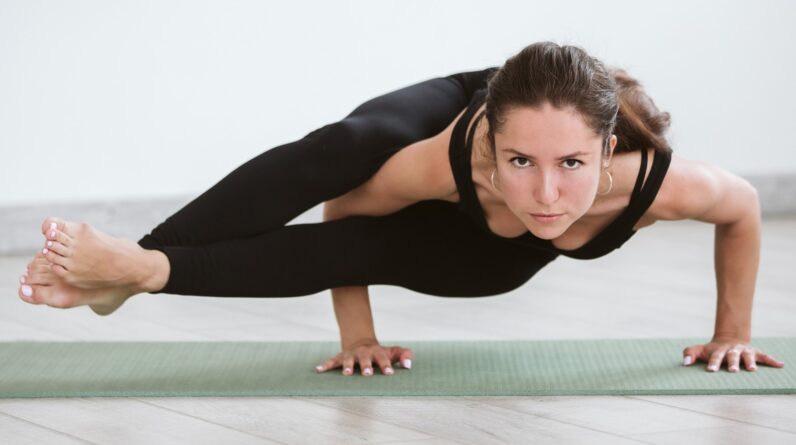
Ashtvakrasama helps enhance your flexibility and boosts concentration. Here are all the benefits of the angle pose and the steps to do it properly.
Long hours of sitting at work might cause back and neck problems. Incorporating the eight angle yoga pose or ashtvakrasana into your fitness regimen could help ease the pain. Ashtavakrasana is a yoga pose that targets the upper body while emphasising on strengthening the arms. This pose also improves posture and body awareness while increasing energy levels. Practising ashtavakrasana helps to improve core stability, and hip mobility and strengthen the upper body to ease the pain. Here’s how to do it properly and all the benefits it has to offer.
What is ashtavakrasana or eight angle pose?
Ashtavakrasana is an advanced yoga posture that combines elements of arm balancing, twisting, and core strength. The name comes from Sanskrit: “Ashta ” meaning eight, “Vakra” meaning bent or angled, and “Asana” meaning pose. The body forms several angles which resemble the figure eight, and gives this asana its name.
“It is a challenging pose that requires a strong upper body, flexible hips, and a stable core. The practitioner balances on their hands while twisting their legs around one arm, creating a complex shape that demonstrates strength, flexibility, and balance,” says yoga expert Himalayan Siddhaa Akshar.
Benefits of ashtavakrasana or eight angle pose
Here are some of the notable benefits of ashtavakrasana or eight angle pose.
1. Improves digestion
“The twisting action in this pose can help stimulate the digestive organs, potentially aiding in digestion. If you are suffering from a digestion problem and looking for effective yoga, incorporating ashtavakrasana can be helpful,” explains the expert.
Also Read


2. Improves flexibility
Regular yoga practice may increase flexibility and balance, as found in a study published in the International Journal of Yoga. The twisting action in the pose helps to open the hips and increase their range of motion. Plus, as you extend your torso forward and reach your legs back, ashtavakrasana stretches the entire back of your body, including your spine. It also lengthens the back of your legs, improving hamstring flexibility.
3. Strengthens the body
Yogasana improves muscular strength, flexibility, and balance, as per a study published in the Journal of Ayurveda and Integrative Medicine. The eight-angle pose improves upper-body strength. It targets the muscles in your back, shoulders, arms, and wrists. This pose engages your abdominal muscles that helps maintain stability and balance. Plus, both your hamstrings and quadriceps get a good stretch and isometric hold in this pose, strengthening the muscles in your thighs.
4. Boosts balance and coordination
If you are looking for ways to improve your body balance and coordination, incorporating ashtavakrasana or eight-angle pose can be helpful. This pose requires maintaining balance and body awareness.
5. Increases focus and concentration
Regular practice of yoga helps to improve concentration, reduces stress and anxiety, and improves overall wellbeing, as found in a study published in the International Journal of Yoga. If you are unable to focus or concentrate on your daily work goals, practising eight angle poses can do wonders for accomplishing your goals. The challenging nature of the pose requires intense mental focus, which can help improve concentration skills.

How to do ashtavakrasana or eight angle pose?
Here is a complete guide on how to do ashtavakrasana or eight angle pose, as explained by the expert.
- Step 1: Start in a squat position with your hands on the floor.
- Step 2: Place your right hand on the floor about a foot in front of your right foot.
- Step 2: Bend your right elbow and place the outside of your right knee high on your right upper arm.
- Step 3: Lean forward, shifting your weight onto your hands.
- Step 4: Lift your left foot off the floor and cross your left ankle over your right.
- Step 5: Extend both legs to the right, keeping them straight and squeezing them together.
- Step 6: Balance your body weight on your hands, lifting your hips.
- Step 7: Optionally, you can turn your head to look forward.
Keep in mind!
Inhale as you prepare, exhale as you shift your weight forward and lift yourself off the ground. Once in the pose, maintain steady, even breaths.
Side effects of ashtavakrasana or eight angle pose
While it is generally considered safe when performed correctly, potential side effects may include:
- Wrist strain or injury can occur if proper alignment is not maintained in the pose.
- Shoulder strain can occur if the pose is held for too long or with an improper form of the pose.
Always listen to your body and adjust the pose as needed for a safe and productive practice. It is also critical to approach it gently and with the support of a professional who can provide suitable instructions and assist you in avoiding injuries.
Frequently Asked Questions
1. When is the best time to perform ashtavakrasana?
The best time is generally in the morning or evening, on an empty stomach. However, as it is an energising pose, some may prefer not to practise it close to bedtime.
2. How long should I hold the pose?
The pose requires only three to five minutes to produce minor physiological changes in the connective tissues. Some trained people maintain the pose for ten minutes, with their body weight supported by props.







